(1) INTRODUCTION TO MEDICAL TECHNOLOGY: SCOPE, NATURE AND HISTORICAL PERSPECTIVE
1/71
Earn XP
Description and Tags
PPT1
Name | Mastery | Learn | Test | Matching | Spaced |
|---|
No study sessions yet.
72 Terms
Ruth Heinemann
(what is medical technology?)
-is the application of natural, physical and biological sciences to the performance of laboratory procedures which aid in the diagnosis and treatment of disease.
Anne Fagelson
(what is medical technology?)
-is the branch of medicine concerned with the performance of laboratory determinations and analyses used in the diagnosis and treatment of the disease and maintenance of health.
Walters
(what is medical technology?)
-is the health profession concerned with performing laboratory analyses in view of obtaining information necessary in the diagnosis and treatment of disease as well as in the maintenance of good health.
RA 5527 (The Philippine Medical Technology Act of 1969)
(what is medical technology?)
(law)
-is an auxiliary branch of laboratory medicine which deals with the examination of tissues, secretion and excretion of human body and body fluids by various chemical, microscopic, bacteriologic and other medical laboratory procedures which will aid the physician in the diagnosis strictly and treatment of disease and in the promotion of health in general.
samples, results, disease
Performing laboratory procedures : ____
Analysis : ____
Diagnosis and treatment : ____
bronze age
(history of clinical laboratory)
-The first accounted records of parasites & parasitic infections were documented in the earliest archaeological materials
-Mysticism, magic, & supernatural beliefs dominated this period
-Priests were regarded as healers & exorcists
-There was no clear knowledge regarding the anatomy of internal organs, but it was generally known that the heart beat or throbbed
iron age
(history of clinical laboratory)
-Practices in disease prevention improved
-Ancient physicians based their first medical diagnoses on what they could observe with their eyes & ears
-The oldest known test on body fluids was done on urine
-In ancient times, Greek physicians made diagnoses by pouring urine on the ground & observing whether the urine attracted insects
300 BC, Hippocrates, blood, phlegm, yellow bile, black bile
(history of clinical laboratory)
Around ____
Ancient Greek physician first had the examinations of human body fluids
____, considered the “father of medicine”, investigated and studied the FOUR HUMORS – ____, ____, ____, ____.
urine, uroscopy
(history of clinical laboratory)
300 BC
____ is one of the body fluids that underwent examination, Hippocrates concluded that the appearance of bubbles, blood and pus in urine indicated kidney disease
____ - “water casting” in Medieval Europe was widely practiced. Patients submitted their urine specimen in decorative flasks
18th century
(history of clinical laboratory)
Mechanical techniques and cadaver dissection were used to provide a more objective and accurate diagnosis and to understand the insides of the body.
1880
(history of clinical laboratory)
Emergence of the causative agents of tuberculosis, diphtheria, and cholera and its detections in the late 1890s.
19th century, john hutchinson, jules herisson
(history of clinical laboratory)
_____ (when)
Physicians began using machines to diagnose and conduct therapy.
____ : Spirometer, measures vital capacity of the lungs
____ : Sphygmomanometer
early 20th century, electron microscope
(history of clinical laboratory)
____ (when)
____ use for visualization of small cells including tumor cells and these discoveries persisted through robotics, keyhole surgery procedures, genetic engineering, and telemedicine (information technology)
20th century to present, era of sophistication, penicillin, streptomycin
(history of clinical laboratory)
____ (when)
This is the ____
Discovery of powerful antibiotics against infectious agents. ____ and ____ were examples of these antibiotics by Alexander Flemming & biochemists Selman Waksman, Alber Schatz, & Elizabeth Bugie.
1908, james campbell todd, john bernard henry
(history of clinical laboratory)
In ____, ____ wrote a book entitled Clinical Diagnosis: A Manual of Laboratory Method.
Later, the book was edited by ____. It was then named Clinical Diagnosis & Management by Laboratory Methods. This book became the fundamental source in the practice of laboratory medicine
quiricada st., sta. cruz, manila, manila public health laboratory
(history of medical laboratory in the philippines)
6TH Infantry Division of the US Army
Established the first clinical laboratory in the Philippines located at ____
Now known as ____
october 1 1945, dr. mariano icasiano, dr. prudencia sta. ana, dr. tirso briones
(history of medical laboratory in the philippines)
Dr. Pio de Roda : ____ (when)
Re-organized the abandoned laboratory when the US army left, with the help of ____ who was a Manila City Health Officer at the time
Along with ____, they conducted a training program for aspiring laboratory workers and organized a six-month formal syllabus for the training program with certificate for the trainees upon completion. Eventually, ____ joined them.
1954, mrs. willa hedrick
(history of medical laboratory in the philippines)
____ (when)
Approval of the four-year course in Bachelor of Science in MT by the Bureau of Private Education
Manila Sanitarium and Hospital (MSH) opened the first school of Medical Technology under the management of ____
The Philippine Union College (now Adventist University of the Philippines) acquired the MedTech School of MSH
Dr. Jesse Umali
(history of medical laboratory in the philippines)
who was the First graduate of the Medical Technology program, now an OB-gynecologist?
1957
(history of medical laboratory in the philippines)
MedTech program was initially offered as an elective for Pharmacy students in UST
1960, 1962
(history of medical laboratory in the philippines)
when did CEU offer the Medical Technology program? ____
when did the First batch graduate? ____
1961, BS in Public Health
(history of medical laboratory in the philippines)
MedTech was officially declared as a program in UST
University of the Philippines – offered the same course but the degree is conferred to as ____.
BSMT, BSMLS, licensure examination
(nature of the medical technology)
Program course shall be called as:
____ and ____
It is a four year program consisting of a one year internship with rotational duties in different sections during the 4th level in a CHED-accredited training laboratory.
A ____ is given to all applicants for registration as Medical Technologist.
Medical Technology
(nature of the medical technology)
To improve the detection, diagnosis, treatment, and monitoring of diseases which holds linkages with many other disciplines for specific diagnostic or therapeutic purposes. Its nature is contextual, interdisciplinary, interdependent, and system-based.
Clinical Laboratory, 70%
(nature of the medical technology)
____ performs the testing in detection, diagnosis, and treatment of diseases.
____ of all decisions performed by medical doctors are based on laboratory test results,
The place where specimens collected from individuals are processed, analyzed, preserved, and properly disposed.
clinical laboratory scientists
(nature of the medical technology)
The one who does perform these tests, usually look for the presence of bacteria, parasites, and other microorganisms in the body. They also prepare specimens for examination, to count cells, and look for abnormal cells in the blood and other body fluids.
R.A. 5527 (Medical Technology Act of 1969)
(nature of the medical technology) The act governing medical technology profession in the Philippines.
Perform Clinical Laboratory Testing
(roles and responsibilities of medical technology professionals)
-Must be capable of performing the most basic to the most advanced laboratory tests.
-Should be able to conduct tests such as urinalysis and stool examination, should be able to perform hematologic, microbiologic, serologic, chemical and other procedures in the different areas of laboratory science.
perform special procedures
(roles and responsibilities of medical technology professionals)
-Perform special procedures in diagnosing diseases. These may include the operation of advanced diagnostic equipment. Special procedures can also include molecular and nuclear diagnostics.
ensure accuracy and precision of result
(roles and responsibilities of medical technology professionals)
-Should be conscious of the accuracy and precision of both the testing process and its results. Accuracy and precision impact the interpretation of the results by the physician to provide proper medication in the treatment of diseases.
be honest in practice
(roles and responsibilities of medical technology professionals)
-Must value honesty, particularly in conveying or reporting the results of any laboratory procedure. Should act according to the Medical Technology profession’s Code of Ethics and his or her pledged Oath of practice.
-A medical technologist must be honest at all times in the conduct of test procedures to come up with accurate and precise results.
ensure timely delivery of results
(roles and responsibilities of medical technology professionals)
-Must be aware of the urgency of delivering results on time, especially in cases that require urgent treatment.
-When physicians request immediate result, one should take notations on “STAT” or even observe the source of the requests
demonstrate professionalism
(roles and responsibilities of medical technology professionals)
-Must be able to perform his or her functions according to the professional Code of Ethics for medical technology professionals.
-Should be aware of the laws and regulations governing the practice of medical technology and should not exploit its function beyond its boundaries.
uphold confidentiality
(roles and responsibilities of medical technology professionals)
-Ensuring confidentiality is one of the core duties within the medical practice
-Confidentiality requires health care providers to keep a patient’s personal health information private unless the patient consents to release the information.
collaborate with other health care professionals
(roles and responsibilities of medical technology professionals)
A requirement to collaborate with other health care practitioners in order to build a well-functioning team. Collaboration is the act of working together in order to achieve a desired outcome. Teamwork is a must.
conduct research
(roles and responsibilities of medical technology professionals)
MedTechs must also be engaged in research activities to update their skills.
involvement in health promotion programs
(roles and responsibilities of medical technology professionals)
-Cooperate with other health care professionals in health promotion campaigns such as promoting the ideal attitudes on hygiene, community sanitation, waste segregation, and disease prevention
-Offer free laboratory testing such as blood typing, urinalysis, fecalysis, blood sugar testing, cholesterol testing, and other tests beneficial to the entire community.
-Collaborate with other health care professionals once diagnoses are done.
clinical chemistry, blood and urine
(sections of clinical laboratory)
____
-Intended for the testing of blood and other body fluids to quantify essential soluble chemicals including waste products useful for the diagnosis of certain diseases.
-____ are specimens used in this section.
-FBS, Lipid Profile, SGPT, SGOT, Liver Profile, Creatinine, BUN, BUA, TPAG, Electrolytes
clinical microbiology
(sections of clinical laboratory)
-Subdivided into four sections: Bacteriology, Mycobacteriology, Mycology, and Virology.
-At present, the work in this section is more focused on the identification of bacteria and fungi on specimens received.
-Although not as automated as clinical chemistry, automated instruments are available such as those used for blood culture and antimicrobial susceptibility testing.
hematology and coagulation studies
(sections of clinical laboratory)
-Deals with the enumeration of cells in the blood and other body fluids.
-Complete Blood Count, Hemoglobin, Hematocrit, WBC Differential Count, Red Cell Morphology and Cell Indices
-Coagulation studies focus on blood testing for the determination of various coagulation factors.
clinical microscopy
(sections of clinical laboratory)
-Determines the macroscopic appearances of urine such as: color, clarity/transparency, pH, specific gravity and the microscopic examination to detect cells, parasites and bacteria and to quantify these.
-In this section, stool or fecal sample is also examined to identify presence of parasitic worms or ova.
blood bank/immunohematology
(sections of clinical laboratory)
-Main activities performed here are the blood typing and compatibility testing
-Also performed are the screening of all antibodies and identification of antibodies
-Considered the most critical in the clinical laboratory
immunology and serology
(sections of clinical laboratory)
-Analyses of serum antibodies in certain infectious agents are performed.
-Serologic tests such as, Hepa B, Syphilis, DRT and some antibody screening tests.
-Automated analyzers and kits are commonly used in this section
clinical, anatomic, molecular pathology
(classification of clinical laboratory)
(according to function)
1. Concerned with the diagnosis and treatment of diseases performed through lab testing of blood and other body fluids
2. Concerned with the diagnosis of diseases through microscopic examination of tissues and organs
3. Deals with the analysis of certain genes, proteins and other molecules in samples from organs, tissues or bodily fluids’
-Based on the principles, techniques and tools of molecular biology as they are applied to diagnostic medicine in the laboratory
institution-based, free-standing
(classification of clinical laboratory)
(according to institutional characteristics)
1. Operates with the premises or part of an institution (Hospitals, schools, med clinic, medical facilities)
2. Not part of an established institution
-Free-standing out-patient clinical lab is a common example
goverment-owned, privately-owned
(classification of clinical laboratory)
(according to ownership)
1. Clinical labs are owned, wholly, or partially, by national or local government units
-Laboratories of DOH-run gov’t hospitals
-San Lazaro Hospital, Jose R. Reyes Memorial Medical Center, UP-PGH
-EVMC
2. Owned, established, and operated by an individual, corporation, institution, association, or organization.
primary
(classification of clinical laboratory)
(according to service capability)
identify which category : clinical microscopy
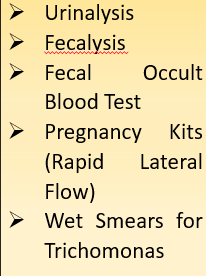
primary
(classification of clinical laboratory)
(according to service capability)
identify which category : clinical chemistry
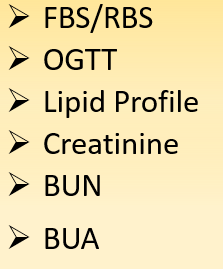
secondary
(classification of clinical laboratory)
(according to service capability)
identify which category : clinical chemistry
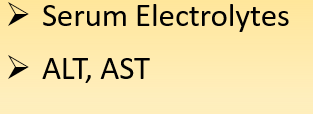
tertiary
(classification of clinical laboratory)
(according to service capability)
identify which category : clinical chemistry
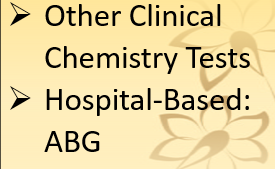
primary
(classification of clinical laboratory)
(according to service capability)
identify which category : clinical hematology
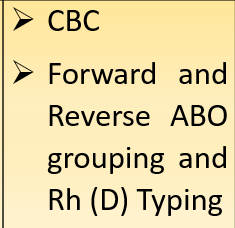
secondary
(classification of clinical laboratory)
(according to service capability)
identify which category : clinical hematology
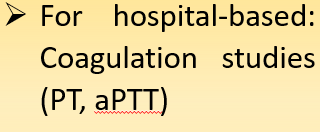
primary
(classification of clinical laboratory)
(according to service capability)
identify which category : immunology and serology

tertiary
(classification of clinical laboratory)
(according to service capability)
identify which category : clinical hematology
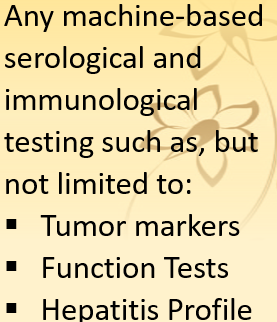
primary
(classification of clinical laboratory)
(according to service capability)
identify which category : microbiology
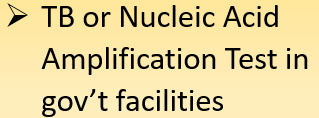
secondary
(classification of clinical laboratory)
(according to service capability)
identify which category : microbiology

tertiary
(classification of clinical laboratory)
(according to service capability)
identify which category : microbiology
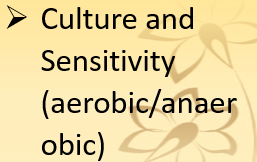
secondary
(classification of clinical laboratory)
(according to service capability)
identify which category : anatomic psychology

tertiary
(classification of clinical laboratory)
(according to service capability)
identify which category : anatomic psychology
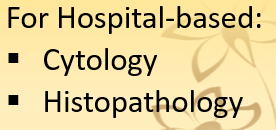
research institute of tropical medicine RITM
(national reference laboratory)
NRL for dengue, Influenza, TB, and other Mycobacteria, Malaria and other parasites, Bacterial enteric disease. Measles and other viral exanthems, Mycology, Enteroviruses, Antimicrobial resistance and engineering diseases
san lazaro hospital SACCL
(national reference laboratory)
NRL for HIV/AIDS, Hepatitis, Syphillis and other Sexually Transmitted Infections
east avenue medical center EAMC
(national reference laboratory)
NRL for environmental and occupational health; toxicology and micronutrient assay
national kidney and transplant institute NKTI
(national reference laboratory)
NRL for Hematology inc., Immunohematology and Immuno-pathology and Anatomic Pathology
philippine heart center PHC
(national reference laboratory)
NRL pathology for Cardiac Disease
lung center of the philippines LCP
(national reference laboratory)
NRL in in atomic pathology for pulmonary disease
pathologist
(defining the practice of other laboratory personnel)
A duly registered physician who is specially trained in methods of laboratory medicine and always considered to head a clinical laboratory and monitor all laboratory results. A laboratory result without the signature of a ____ may not be considered valid.
medical laboratory technicians
(defining the practice of other laboratory personnel)
A person certified by and registered with the Board of Medical Technology and qualified to assist a medical technologist and/or qualified pathologist in the practice of medical technology.
Qualifications:
Fail to pass the medical technology licensure examination given by the Board of Medical Technology but obtained a general rating of at least 70% and provided finally that RMLT when employed in the government shall have civil service eligibility not lower than the second grade.
phlebotomist
(defining the practice of other laboratory personnel)
-An individual trained to draw blood either for laboratory tests of for blood donations.
-Arterial collection can only be performed by a specially trained ____. ____ is a skill confined not only to medical technologists but to other health care practitioners as well, provided that they were given certificates.
In the Philippines, an RMT is required to be skilled in ____, although in other countries, phlebotomist need not get a degree.
cytotechnologist
(defining the practice of other laboratory personnel)
A lab personnel who works with the pathologist to detect changes in body cells which may be important in the early diagnosis of diseases. They select and section minute particles of human tissues for microscopic study using microtome and other equipment.
histotechnologist
(defining the practice of other laboratory personnel)
responsible for the routine, processing, and staining of biopsies and tissue specimens for microscopic examination by a pathologist.
nuclear medical technologist
(defining the practice of other laboratory personnel)
Works alongside nuclear physicians. They apply their knowledge of radiation physics and safety regulations to limit radiation exposure, prepare and administer radiopharmaceuticals, and use radiation detection devices that measure the quantity and distribution of radionucleotides deposited in the patient or in the patient’s specimen.
toxicologist
(defining the practice of other laboratory personnel)
Studies the effects of toxic substances on the physiological functions of human beings to develop data for use in consumer protection and industrial safety programs.